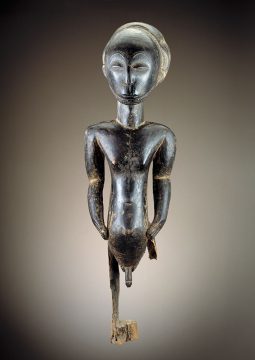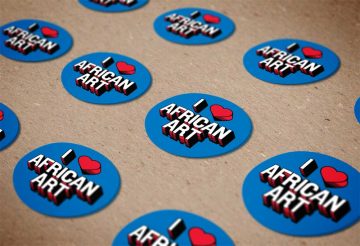
That Liberty and Equality Might Yet Reign
“Brothers and friends, I am Toussaint Louverture; perhaps my name has made itself known to you. I have undertaken vengeance. I want Liberty and Equality to reign in St. Domingue. I am working to make that happen. Unite yourselves to us, brothers, and fight with us for the same cause.”
—Toussaint Louverture, Camp Turel, Aug. 29, 1793
Paa Joe
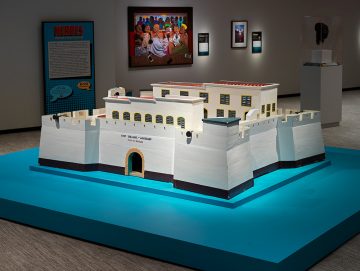
b. 1947, Akwapim, Eastern Region, Ghana
Works in Pobiman, Greater Accra Region, Ghana
Fort William-Anomabu
2004–5; made in Nungua, Ghana
Wood, enamel paint
Gift of Jack Shainman Gallery, New York, in memory of Claude Simard, 2014-14-1
Forts at Anomabu traded hands between the Netherlands, Sweden, Denmark and, finally, Britain from the mid-17th century. Of all the European forts built on what was then termed the Gold Coast, Fort William was one of the only to have a prison purposely built within its walls to hold enslaved peoples awaiting transport for forced labor in the Americas. The fort was the center of the British market in captured peoples until the trade was outlawed in 1807.
Paa Joe is one of the best-known and prolific innovators of a new art form that has developed on the outskirts of Accra in the last half century—"fantasy coffins,” sculpted in a wide variety of forms that memorialize their future residents’ key accomplishments in life. In the style of these coffins, Paa Joe created a series of architectural models of Ghana’s coastal forts—global sites of memory, conscience, and loss.
Hero in History: Ignatius Sancho

- Brought to England in childhood, Sancho learned to read; he devoured books.
- Sancho set up a shop in Westminster with his wife, which allowed him the right to vote in parliamentary elections; he was the first black man to vote in Britain.
- His letters, published posthumously, were one of the earliest accounts of slavery in English, and became a rallying point in the growing abolitionist movement.
“I am sorry to observe that the practice of your country (which as a resident I love)…has been uniformly wicked in the East and West-Indies—and even on the coast of Guinea. The grand object of English navigators—indeed of all Christian navigators—is money—money—money…In Africa…the Christians' abominable traffic for slaves and the horrid cruelty and treachery of the petty Kings [are] encouraged by their Christian customers who carry them strong liquors to enflame their national madness—and powder—and bad fire-arms—to furnish them with the hellish means of killing and kidnapping.”
—Ignatius Sancho“I am Sir an Affrican—with two ffs—if you please—& proud am I to be of a country that knows no politicians—nor lawyers—no—nor Thieves.”
—Ignatius SanchoOusmane Sow

(1935-2016, b. Dakar, Senegal; worked in Dakar)
Toussaint Louverture et la vielle esclave [Toussaint Louverture and the elderly enslaved woman]
1989
Mixed media (iron, earth, jute, straw, other organic materials)
Museum purchase, through exchange from Emil Eisenberg, and Mr. and Mrs. Norman Robbins, and with funds from Stuart Bohart and Barbara Portman, 2009-8-1
A black liberation leader stands holding out his hand, staring into an as-yet-unrealized future, as a formerly enslaved woman rises.
Ousmane Sow created this work as part of a series of sculptures commemorating the bicentennial of the French Revolution. Unlike those sculptures, however, Toussaint Louverture depicts a figure who actually struggled against the French state, taking on the mantle of the original revolutionary principles surrendered by that point back in Paris to the authoritarian rule of Napoleon.
The military leader of the Haitian Revolution, Louverture successfully channeled an uprising of free people of color and, later, enslaved people, into an armed movement that, by 1800, had ended both slavery and French rule on the island. Louverture became the head of the Western Hemisphere’s second independent revolutionary state—and its first leader of African descent..
Hero in History: Toussaint Louverture

- From a plantation birth to an early life as a wealthy free man, he achieved a wide-ranging education. He took the surname Louverture, from the French term for “opening.”
- Louverture led a slave rebellion from 1791, switching sides and defeating the armies of three world powers: Spain, the United Kingdom, and France.
- Ruling a St. Dominigue freed from French rule, Louverture then codified the abolition of slavery in the new nation, soon to be renamed Haiti.
“Brothers and friends, I am Toussaint Louverture; perhaps my name has made itself known to you. I have undertaken vengeance. I want Liberty and Equality to reign in St. Domingue. I am working to make that happen. Unite yourselves to us, brothers, and fight with us for the same cause.”
— Toussaint Louverture, speaking at Camp Turel, Aug. 29, 1793Hemba artist
Hero in History: Patrice Lumumba

- Lumumba formed the Mouvement National Congolais, advocating for independence from Belgium.
- He was the first prime minister of independent Congo. Lumumba was seen as a pan-African symbol of African rectitude and resistance to colonialism.
- Overthrown within his first year in office, Lumumba was then murdered with covert assistance from the West.
All during the length of my fight for the independence of my country, I have never doubted for a single instant the final triumph of the sacred cause to which my companions and myself have consecrated our lives. But what we wish for our country, its right to an honorable life, to a spotless dignity, to an independence without restrictions, Belgian colonialism and its Western allies . . . have not wished it . . . Without dignity there is no liberty, without justice there is no dignity, and without independence there are no free men.
—Patrice Lumumba, to his wife while imprisoned, Dec. 1960Gora Mbengue

1931–1988, b. Thiadiaye, Thiès Region, Senegal
Worked in Gorée, Dakar Region, Senegal
Untitled (Sheikh Amadou Bamba)
Late 20th century
Paint on glass
Bequest of Charlton E. Williams, 2002-14-19
Hero in History: Sheikh Amadou Bamba

- Sheikh Bamba founded the Mouride brotherhood in Touba, Senegal in 1883; he emphasized pacifism, hard work, and self-improvement.
- When French colonial leaders were promoting Christianization and assimilation, Sheikh Bamba asserted his submission to God alone. Fearing his example, he was exiled by the French authorities for 12 years.
- Today, the Mouride order consists of at least five million members—in Senegal, and globally.
“O you the Just, the Good by excellence, the Preserver! O You who heal and who hold man’s destiny in Your hands! Let Your blessings descend where harm exists And let there be good where evil prevails. And let there be generosity where avarice prevails. Let wealth be showered in poor places and let there be gratitude where ingratitude prevails...”
—Sheikh Amadou Bamba, The Quest for HealingGhada Amer
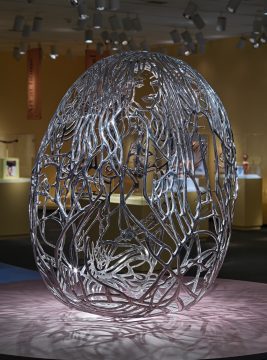
(b. 1963, Cairo, Egypt; works in New York)
The Blue Bra Girls
2012
Casted, polished stainless steel
Museum purchase, 2018-2-1
The Blue Bra Girls commemorates women who gathered in central Cairo in 2011, initially to protest the abuses of the administration of president Hosni Mubarak, in his thirtieth year in power, and then to demonstrate for political openness in the turmoil that followed his fall.
In this sculpture, Amer makes reference to a widely circulated photo from that uprising—of an anonymous woman so violently beaten and dragged by the police that her black abaya was lifted, leaving her torso bare except her for her blue bra. As the image circulated globally, Cairo in December 2011 saw the largest political gathering of women since the anti-occupation demonstrations organized by feminist leader Huda Sha’arawi in 1919.
Hero in History: Huda Sha’arawi
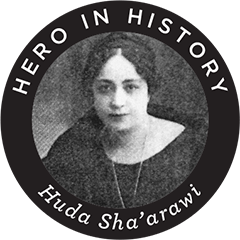
- Sha’arawi was an Egyptian feminist leader. She founded the Egyptian Feminist Union (1923).
- An anti-colonial activist, Sha’arawi organized Egypt’s largest women-led anti-British demonstration (1919), a milestone in the events leading to Egypt’s independence in 1922.
- Sha’arawi refused to wear the hijab in public after 1922.

